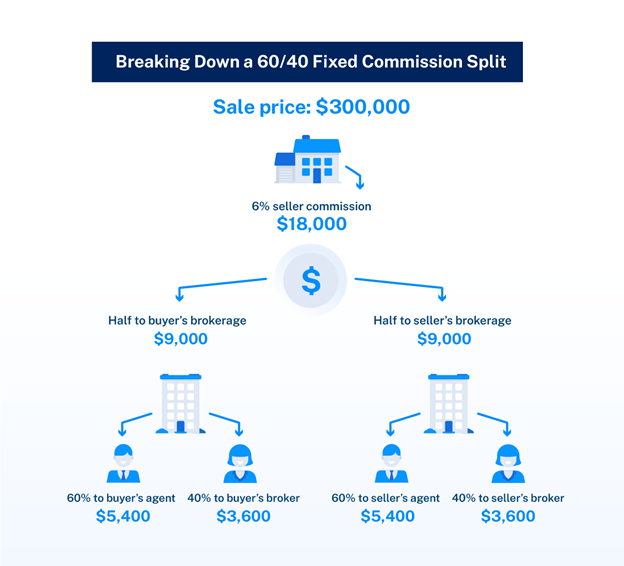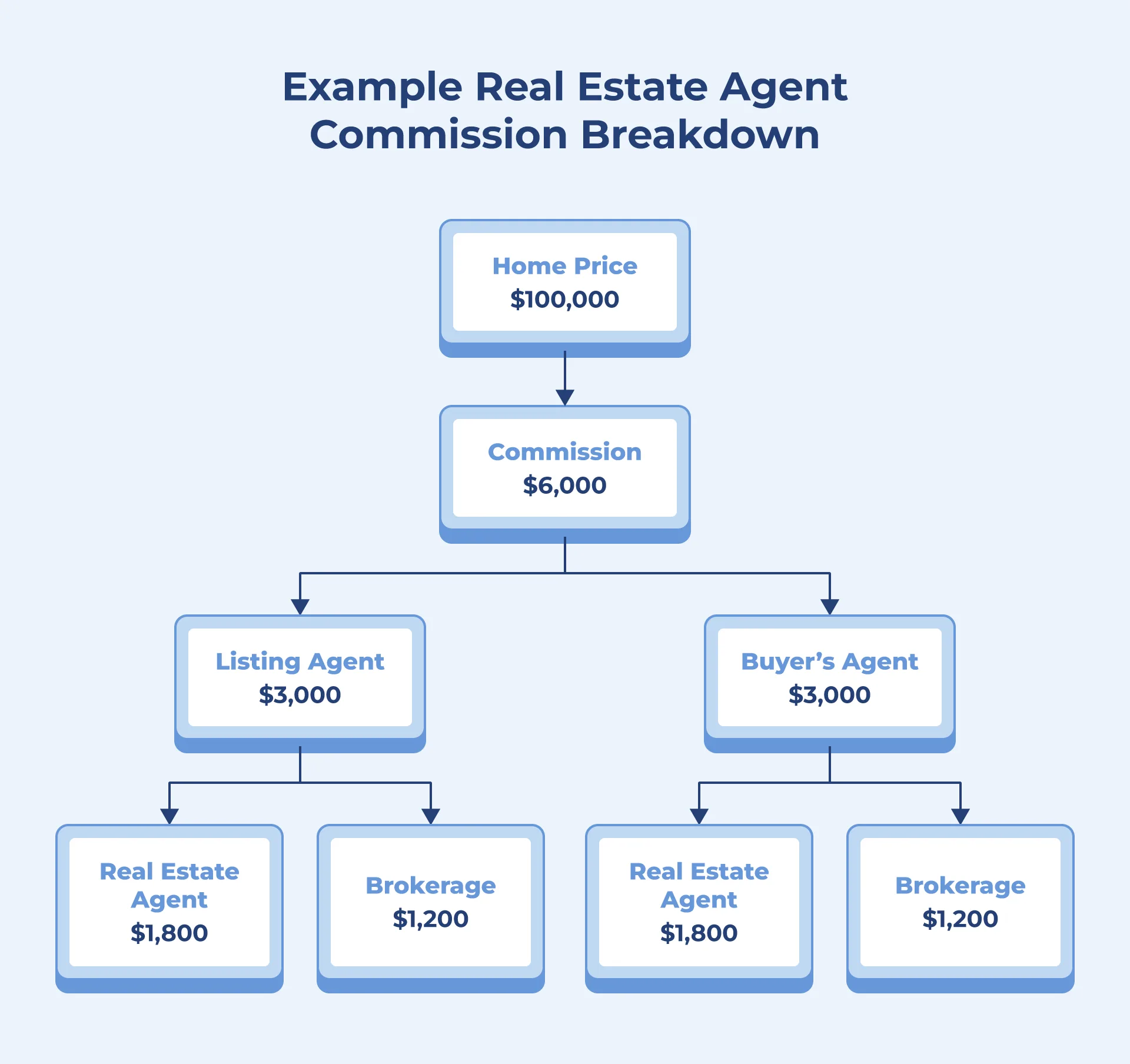Real estate brokers commonly earn income from base salaries and commissions split between buyer’s and listing brokers. Some firms offer tiered commission structures for agents, providing higher percentages based on performance.
Commission rates are negotiable during the hiring process, with agents sharing a portion with their sponsoring brokers. Each transaction’s commission is typically divided equally between brokers involved in the sale. In Texas, real estate agents determine specific percentages for commission splits, allowing for flexibility and negotiation opportunities.
Understanding the nuances of real estate commission structures is crucial for both brokers and agents to maximize earnings and foster successful partnerships within the industry.

Credit: blog.constellation1.com
Understanding Real Estate Broker Commission Structures
In the real estate industry, understanding commission structures is crucial for both brokers and agents. Commission structures define how agents are compensated for their services and play a significant role in the financial aspect of real estate transactions. It is essential to comprehend the various components of real estate commission structures to make informed decisions and negotiate fair compensation. This article delves into the intricacies of real estate broker commission structures to provide a comprehensive understanding of how commissions are structured and determined.
Real Estate Brokerage Commission Split Explained
When it comes to real estate brokerage commission split, it refers to the division of the commission between the listing broker and the buyer’s broker. In this scenario, the total commission is usually divided equally between the two brokers, with each receiving a predetermined percentage. This split arrangement ensures that both the listing broker and the buyer’s broker receive fair compensation for their contributions to the successful completion of the real estate transaction.
Determining Broker Commissions
Broker commissions are typically determined based on a percentage of the final sale price of the property. The specific percentage can vary based on the brokerage firm’s commission structure, the agent’s experience level, and the local real estate market conditions. Additionally, some brokerage firms may offer tiered commission split structures, where agents receive a higher percentage of the commission as they achieve certain sales volume or performance targets.
In conclusion, understanding real estate broker commission structures is crucial for all parties involved in real estate transactions. By gaining insights into the intricacies of commission splits and the factors that determine broker commissions, agents and brokers can make informed decisions that ensure fair compensation and sustainable business growth.
Average Real Estate Commissions
Real estate commissions refer to the fees paid to real estate brokers for their services. The average commission rates can vary based on factors such as location, property type, and market conditions.
National Average Commission Rates
In the United States, the national average commission rate for real estate transactions typically ranges between 5% to 6% of the property’s final sale price.
Commission Rates In Texas And California
Specifically, in Texas and California, commission rates can vary from the national average, with some regions seeing rates as low as 4% or as high as 7%.
Real Estate Compensation Plans
In the world of real estate, compensation plans are a crucial aspect of determining how real estate brokers get paid. Real estate brokers generally earn their income from two primary sources: a base salary and commissions. The structure of these commission plans can vary depending on the brokerage firm and the agreement between the broker and the agent. In this blog post, we’ll explore the different income sources for real estate brokers and delve into the tiered commission split structure.
Real estate brokers rely on two main sources of income: a base salary and commissions. The base salary provides a steady income stream, allowing brokers to cover their basic expenses. However, the majority of a broker’s earnings come from commissions, which are a percentage of the transaction value. Commissions are typically earned when a broker successfully helps a client buy or sell a property.
Commissions are usually divided between the buyer’s broker and the listing broker. The division of commissions can vary depending on the brokerage firm and the specific agreement between the brokers involved. From there, commissions may be further distributed among team members or assistants.
Some brokerage firms offer real estate professionals a tiered commission split structure. In this arrangement, agents receive a higher percentage of the commission as their sales volume increases. This incentivizes agents to work harder and achieve higher sales numbers.
| Sales Volume | Commission Split |
|---|---|
| Less than $100,000 | 50% |
| $100,000 – $500,000 | 60% |
| $500,000 – $1 million | 70% |
| Above $1 million | 80% |
This tiered commission split structure motivates agents to increase their sales volume and earn a higher commission percentage. It rewards hard work and success in the real estate industry.
Overall, real estate compensation plans are an important aspect of the industry. They determine how brokers get paid and incentivize agents to achieve higher sales volume. Whether it’s through a base salary and commission structure or a tiered commission split, these plans play a crucial role in the success of real estate brokers.

Credit: raleighrealtyhomes.com
How Real Estate Agents Get Paid
Real estate agents receive their income from a base salary and commissions. The commission structure typically involves a split between the buyer’s broker and the listing broker, divided based on the negotiated terms during the hiring process. Some brokerage firms offer tiered commission splits, providing agents with varying percentage levels.
Commission Structure
The commission structure for real estate agents outlines how they are compensated for their services. Typically, agents earn their income through a combination of a base salary and commissions. The commission is usually a percentage of the sale price of a property and is split between the buyer’s broker and the listing broker.Negotiating Commissions
When it comes to determining the amount of commission a real estate agent receives, there is room for negotiation. During the hiring process, agents and their sponsoring brokers will negotiate how much of the commission will be shared. This negotiation allows agents to advocate for a percentage that is fair and reflects the value they bring to the transaction.Understanding Commission Structures
To better understand commission structures, it is important to know that some brokerage firms offer a tiered commission split system. In this structure, agents receive a higher percentage of the commission as their sales volume increases. This provides an incentive for agents to work hard and generate more business.Factors Influencing Commission Rates
Several factors can influence the commission rates that real estate agents charge. These factors include the location of the property, the complexity of the transaction, the level of expertise and experience of the agent, and the current market conditions. It is important for agents to consider these factors when determining their commission rates to ensure they align with the value they provide.Are Flat Fees An Option?
While commission-based structures are common in the real estate industry, some agents and brokers may also offer flat fees as an alternative. Flat fees provide a fixed rate for the agent’s services, regardless of the property’s sale price. This can be a preferred option for some clients who want certainty in their costs.Conclusion
In conclusion, real estate agents get paid through a commission structure that includes a percentage of the property’s sale price. The commission is split between the buyer’s broker and the listing broker. Negotiating commission rates is possible during the hiring process, and some agents may also offer flat fees as an alternative. Overall, understanding commission structures and the factors that influence commission rates is essential for both agents and clients.Factors Affecting Real Estate Commission Structures
When it comes to real estate transactions, one of the key factors that buyers and sellers need to consider is the commission structure. Real estate broker commissions are the fees that agents receive for their services in facilitating a successful sale. Understanding the factors that affect real estate commission structures is crucial for both buyers and sellers to make informed decisions. Let’s take a closer look at some of the key factors:
Geographical Variances
Geographical location plays a significant role in determining real estate commission structures. Different regions, cities, and even neighborhoods may have varying commission rates. Agents in high-demand areas with a competitive market may charge higher commission rates due to increased buyer demand and property values. On the other hand, in less competitive or slower markets, agents may be more flexible when negotiating their commissions.
Negotiation Flexibility
When it comes to real estate commission structures, negotiation flexibility varies between different agents and brokerage firms. Some firms offer a tiered commission split structure, where agents receive a higher percentage of the commission based on their performance or sales volume. This can be advantageous for agents who consistently achieve high sales numbers. However, other firms may have a fixed commission structure that is non-negotiable, providing less flexibility for agents and potentially impacting their overall earnings.
It’s important for buyers and sellers to understand the negotiation flexibility of the agents and firms they are working with, as this can affect the final commission structure and potentially impact their overall costs or earnings.
In conclusion, the factors affecting real estate commission structures include geographical variances and negotiation flexibility. These factors can significantly impact the commission rates charged by agents and brokerage firms. By understanding these factors, buyers and sellers can make informed decisions and negotiate favorable commission structures that align with their needs and expectations.

Credit: vprsuccess.com
Impact Of Commission Structures On Earnings
Real estate brokers’ earnings are directly influenced by the commission structures they operate under. The way commissions are structured can have a significant impact on the profits of real estate agents, thereby affecting realtor fees and overall earning potential.
Profits For Real Estate Agents
Real estate agents’ profits are greatly influenced by the commission structures they work within. Tiered commission split structures or flat fee arrangements can significantly impact the earnings of real estate agents. These structures can either increase or decrease an agent’s take-home pay, affecting their overall profits.
Realtor Fees And Commissions
Understanding the realtor fees and commissions is vital in the real estate industry. The commission structures directly dictate the amount of fees that agents and brokers receive from property transactions. It is important for real estate professionals to have a clear understanding of how commission structures affect their earnings.
Challenges And Controversies
Real estate broker commission structures have long been a source of contention and debate within the industry, with various challenges and controversies surrounding the fairness of commission splits and pivotal changes in commission structures.
Fairness Of Commission Splits
One of the key controversies surrounding real estate broker commission structures is the fairness of commission splits. While some argue that the traditional 50/50 split between the listing broker and the buyer’s broker is outdated and inequitable, others believe that it provides a balanced incentive for both parties involved in the transaction.
Pivotal Changes In Commission Structures
The real estate industry has witnessed pivotal changes in commission structures, with some brokerage firms offering tiered commission split structures. This arrangement provides agents with the opportunity to earn a higher percentage of the commission based on their performance, leading to discussions about the impact of such changes on the overall dynamics of the industry.
The Future Of Real Estate Commissions
The future of real estate commissions is continuously evolving, with new trends and digital disruptions reshaping commission structures across the industry. Understanding these changes is crucial for real estate brokers to stay competitive and adapt to the shifting landscape of commission models.
Trends In Commission Models
Real estate brokerage firms are exploring innovative commission models to better align incentives between agents and clients. One emerging trend is the tiered commission split structure, where agents can earn higher percentages based on performance levels.
Digital Disruption And Commissions
Digital technologies have revolutionized the real estate industry, impacting how commissions are negotiated and paid. Online platforms and marketplaces are streamlining commission processes, enabling agents to receive payments faster and more transparently.
Frequently Asked Questions
What Is A Real Brokerage Commission Split?
A real brokerage commission split refers to the division of commissions between the agent and the brokerage. Some firms offer tiered structures, giving agents a higher percentage based on performance. This structure varies between brokerages and can impact an agent’s earnings.
What Is The Amount Of A Broker’s Commission Usually?
The amount of a broker’s commission usually varies, but the average commission is around 5-6%.
How Are Broker Commissions Typically Determined?
Broker commissions are typically determined through a percentage of the property’s selling price. Commission splits may vary.
What Percentage Do Most Realtors Charge In Texas?
Most realtors in Texas charge a percentage of the property’s selling price as commission.
Conclusion
In understanding real estate broker commission structures, it’s crucial to grasp the various models and fee arrangements available. Agents and brokers navigate these options to determine their compensation, impacting both income and performance. It’s essential to weigh the commission split structure to optimize profitability and success in the real estate industry.

Pavel Zelenka is a seasoned expert in the realms of long-term and value capital investment, as well as angel investing. With a robust background in finance and strategic investment, Pavel Zelenka has distinguished herself as a trusted advisor in the dynamic landscape of wealth creation. Her expertise in long-term investment strategies involves a meticulous approach to identifying opportunities that align with sustained growth and value creation over time. Additionally, Pavel Zelenka excels in valuing capital investments, employing a comprehensive understanding of market trends and asset valuation to guide her decision-making process.
Furthermore, as an angel investment expert, Pavel Zelenka actively engages in supporting and nurturing early-stage ventures. Her keen eye for promising startups, coupled with a strategic approach to angel investing, positions her as a valuable mentor for entrepreneurs seeking not just financial backing but also strategic guidance. Pavel Zelenka’s contributions to the fields of long-term investment, capital valuation, and angel investing underscore her commitment to fostering sustainable growth and innovation in the financial landscape.


